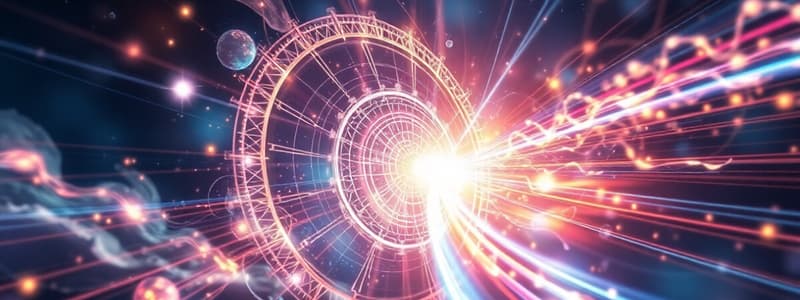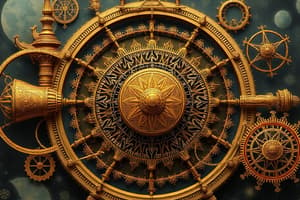Podcast
Questions and Answers
Which of the following statements is NOT a characteristic of modern physics?
Which of the following statements is NOT a characteristic of modern physics?
- It has applications in fields like nuclear power and technology development.
- It describes phenomena at the atomic and subatomic levels.
- It is based on the principles of Newton's laws of motion. (correct)
- It incorporates concepts like wave-particle duality and quantum entanglement.
Which of the following accurately describes the relationship between special relativity and general relativity?
Which of the following accurately describes the relationship between special relativity and general relativity?
- Special relativity deals with accelerated frames of reference, while general relativity deals with inertial frames of reference.
- Special relativity is a special case of general relativity, applicable only in the absence of gravity. (correct)
- Special relativity deals with uniform motion, while general relativity deals with accelerated motion and gravity.
- General relativity is a special case of special relativity, applicable only in the presence of strong gravitational fields.
Which phenomenon primarily governs the functioning of optical instruments like lenses and mirrors?
Which phenomenon primarily governs the functioning of optical instruments like lenses and mirrors?
- Interference, where light waves interact to create patterns of constructive and destructive interference.
- Diffraction, where light bends around obstacles or spreads out after passing through an opening.
- Polarization, where light waves oscillate in a specific plane.
- Refraction, where light bends as it passes from one medium to another. (correct)
Which of the following statements best describes the concept of wave-particle duality in modern physics?
Which of the following statements best describes the concept of wave-particle duality in modern physics?
Which of the following is NOT a direct consequence of the principles of modern physics?
Which of the following is NOT a direct consequence of the principles of modern physics?
Which statement accurately describes Newton's first law of motion?
Which statement accurately describes Newton's first law of motion?
What interpretation does the second law of thermodynamics provide concerning isolated systems?
What interpretation does the second law of thermodynamics provide concerning isolated systems?
How do electric charges interact according to the principles of electromagnetism?
How do electric charges interact according to the principles of electromagnetism?
What limitation is acknowledged within classical mechanics?
What limitation is acknowledged within classical mechanics?
Which of the following statements about momentum is true within classical mechanics?
Which of the following statements about momentum is true within classical mechanics?
How is light understood in optics?
How is light understood in optics?
Which law establishes the concept of thermal equilibrium in thermodynamics?
Which law establishes the concept of thermal equilibrium in thermodynamics?
What is a characteristic of electromagnetic waves?
What is a characteristic of electromagnetic waves?
Flashcards
Refraction
Refraction
The bending of light as it passes from one medium to another, like from air to water.
Diffraction
Diffraction
The bending of light waves around obstacles or through narrow openings, causing the light to spread out.
Quantum Mechanics
Quantum Mechanics
A branch of physics that studies the behavior of matter and energy at the atomic and subatomic levels.
General Relativity
General Relativity
Signup and view all the flashcards
Special Relativity
Special Relativity
Signup and view all the flashcards
What is classical mechanics?
What is classical mechanics?
Signup and view all the flashcards
Newton's First Law
Newton's First Law
Signup and view all the flashcards
Newton's Second Law
Newton's Second Law
Signup and view all the flashcards
Newton's Third Law
Newton's Third Law
Signup and view all the flashcards
What is Thermodynamics?
What is Thermodynamics?
Signup and view all the flashcards
Second Law of Thermodynamics
Second Law of Thermodynamics
Signup and view all the flashcards
What is Electromagnetism?
What is Electromagnetism?
Signup and view all the flashcards
What are key concepts in Optics?
What are key concepts in Optics?
Signup and view all the flashcards
Study Notes
Classical Mechanics
- Classical mechanics describes the motion of macroscopic objects.
- It's based on Newton's laws of motion.
- Newton's first law states that an object at rest stays at rest and an object in motion stays in motion with the same speed and in the same direction unless acted upon by an unbalanced force.
- Newton's second law states that the acceleration of an object is directly proportional to the net force acting on it and inversely proportional to its mass. (F = ma)
- Newton's third law states that for every action, there is an equal and opposite reaction.
- Concepts like momentum, energy, and work are fundamental to classical mechanics.
- Classical mechanics accurately describes the motion of everyday objects.
- It has limitations in describing the motion of extremely small particles or objects moving at extremely high speeds.
Thermodynamics
- Thermodynamics deals with heat, work, and temperature.
- It studies the relationships between these quantities and the properties of matter.
- The zeroth law of thermodynamics establishes the concept of thermal equilibrium.
- The first law of thermodynamics establishes the principle of conservation of energy within a thermodynamic system.
- The second law of thermodynamics states that the total entropy of an isolated system can only increase over time. This relates to the direction of spontaneous processes.
- The third law of thermodynamics states that the entropy of a perfect crystal approaches zero as the temperature approaches absolute zero.
- Thermodynamics has applications in various fields, including engineering, chemistry, and biology.
Electromagnetism
- Electromagnetism describes the interaction between electric charges and magnetic fields.
- Electric charges exert forces on each other. Like charges repel, opposite charges attract.
- Electric fields surround electric charges.
- Magnetic fields surround moving electric charges, or magnetized materials.
- Electromagnetic waves are formed by changing electric and magnetic fields. Light is an example.
- Electromagnetism is crucial for understanding many phenomena, including light, electricity, and magnetism.
- Maxwell's equations describe the fundamental laws of electromagnetism.
Optics
- Optics deals with the behavior of light.
- Light can be described as waves or particles (photons).
- Reflection, refraction, and diffraction are key concepts in optics.
- Reflection occurs when light bounces off a surface.
- Refraction occurs when light bends as it passes from one medium to another.
- Diffraction occurs when light bends around obstacles or spreads out after passing through an opening.
- Optical instruments, like lenses and mirrors, utilize these principles to manipulate light.
Modern Physics
- Modern physics extends classical physics to describe phenomena at the atomic and subatomic levels.
- Quantum mechanics describes the behavior of matter and energy at the atomic and subatomic level.
- Special relativity describes space and time in relation to an observer's motion.
- General relativity describes gravity as a curvature of spacetime.
- Concepts like wave-particle duality, quantum entanglement, and the uncertainty principle are central to modern physics.
- Modern physics revolutionized our understanding of the universe.
- It has wide-ranging applications, from nuclear power to the development of new technologies.
Studying That Suits You
Use AI to generate personalized quizzes and flashcards to suit your learning preferences.




